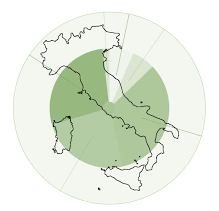In 2022 in Tuscany, lung cancer caused 195 and 541 years of life lived with disability (YLD) in women and men, respectively, corresponding to about 9 and 25 YLD per 100,000 people. Of these, about 53% in women and 66% in men were caused by smoking.
These data come from the ACAB(Attributable Cancer Burden in Tuscany) study, a project funded by the Region of Tuscany under the 2018 Health Research Call for Proposals conducted by the Institute for the Study and Prevention and Oncology Network (ISPRO) in Florence, in collaboration with the University of Florence and the Azienda Sanitaria Locale Toscana Centro. The analysis highlights the significant contribution of tobacco use to the burden of disease, confirming the central role of smoking in the development of the disease.
Lo study, partly based on methodological solutions of the Global Burden of Disease Project, is based on data from the Region of Tuscany’s Cancer Registry (RTRT), which covers the entire population residing in the region, and health surveys conducted at the local level, including those related to the prevalence of tobacco use. YLDs are an indicator that measures years lived with disability due to chronic diseases, such as lung cancer, and are a crucial metric for assessing the reduction in quality of life in a population.
Among the strengths of the study is that it has developed a methodology that can be applied in other contexts, such as other geographical areas or for the study of other diseases or risk factors. Secondly, there is the use of up-to-date data that are as local as possible and, finally, taking into account all sources of uncertainty.
Specifically, to estimate the population distribution between former smokers and nonsmokers, the researchers applied a Bayesian statistical regression model, an advanced approach that allowed for age-, sex-, and geographic-area-specific estimates with an associated measure of uncertainty. A model was also developed to simulate the distribution of smokers by pack-years, a measure that allows for accounting for both intensity and duration of smoking habit. Similarly, in considering the risk associated with past smoking habit, time since smoking cessation was taken into account and appropriately modeled. ThePopulation Attributable Fraction (PAF), a measure that estimates the proportion of cases of disease that could be prevented in the absence of exposure to the risk factor, was then used to estimate the proportion of cases attributable to smoking. For lung cancer, the PAF was particularly high, especially among men, indicating the urgency of targeted preventive interventions.
Another key element of the study was the application of disability weights specific to each stage of lung cancer, including initial diagnosis, primary therapy, metastasis, and the terminal stage of the disease. These weights, also with associated measures of uncertainty, reflected the severity of disability in each stage and were instrumental in calculating YLDs. For example, patients in the advanced stages of the disease experience much greater disability than those in the early stages due to progressive loss of physical function and intensity of treatments.
The use of local data made it possible to produce a sub-regional level estimate, revealing slight geographic variability in the distribution of lung cancer-related YLDs in Tuscany. Some areas, such as rural areas or those with a historical prevalence of workers exposed to harmful environmental factors, have significantly higher rates of disability than urban areas.
In the Tuscan context, these data prove essential for health planning, as they allow estimation with up-to-date, local data, not only of the overall impact of the disease and possible attribution to smoking, but also of geographic inequalities suggesting the need for locally targeted preventive interventions, such as smoking awareness campaigns, smoking cessation programs, and policies to reduce exposure to other risk factors.
The long-term goal is to further reduce tobacco exposure in the population and decrease the burden of lung cancer, helping to improve quality of life and reducing health care costs associated with managing this disease.

